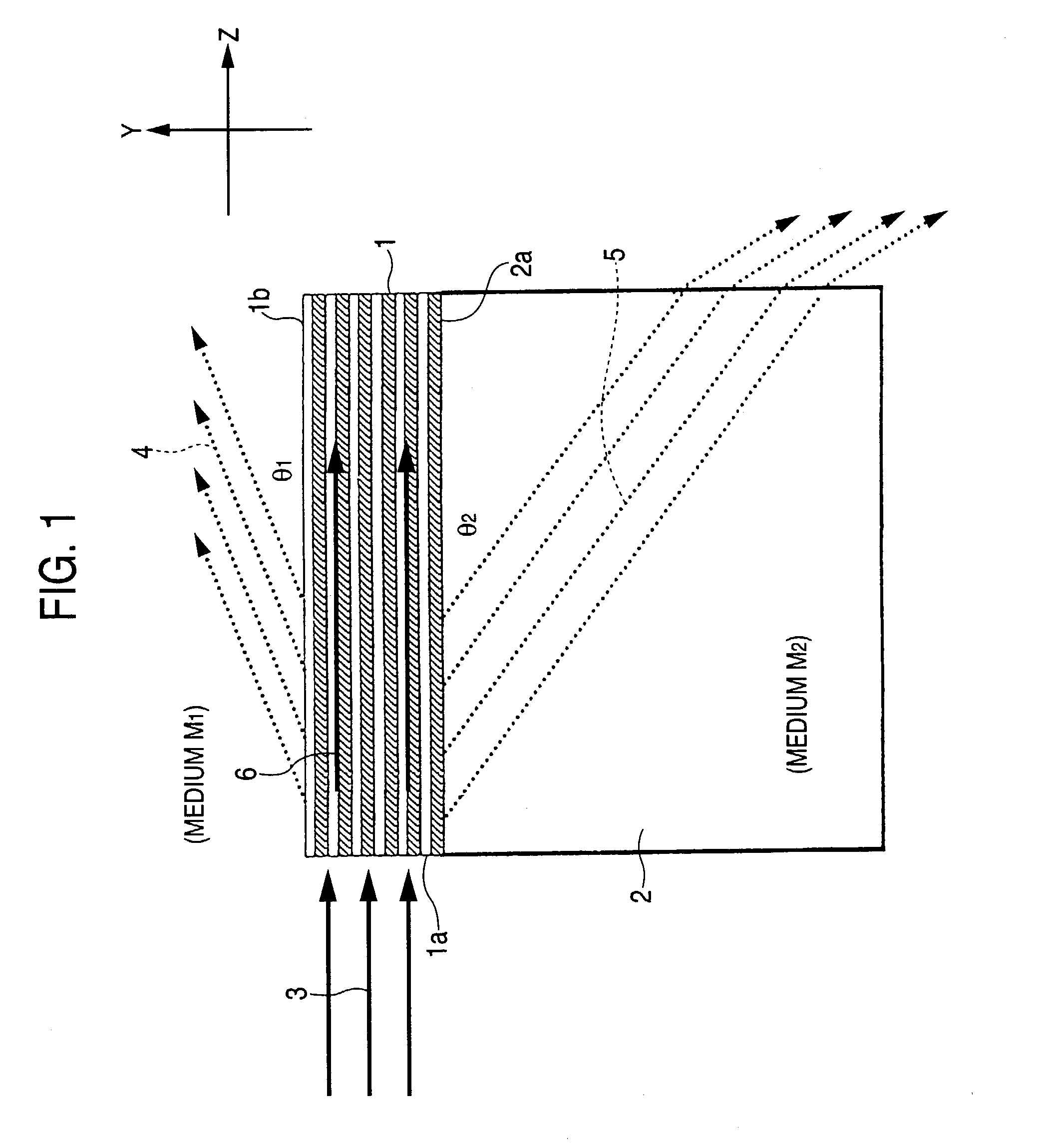Optical element and spectroscopic device using the same
a technology of optical elements and spectroscopic devices, applied in the direction of optical radiation measurement, polarising elements, instruments, etc., can solve the problem that the size of the device cannot but become larg
- Summary
- Abstract
- Description
- Claims
- Application Information
AI Technical Summary
Benefits of technology
Problems solved by technology
Method used
Image
Examples
example 1
CALCULATION EXAMPLE 1
[0151]In Calculation Example 1, the medium A was made of air, the medium B was made of a substrate (n=1.44), and the multilayer film had a structure simply constituted by two kinds of layers. One period of the multilayer film was constituted by two layers equal in thickness to each other. The refractive indices of the two layers were 3.48 and 1.44 respectively.
[0152]According to results of band calculation (FIG. 22) using a plane wave method, effective refractive indices for the first and third band light rays propagated through the periodic structural portion are 3.23 and 1.17 respectively. It is predictable that the following result can be obtained.
[0153]Medium A (air) side: no refracted light generated
[0154]Medium B (substrate) side: third band refracted light generated (θ=35.7°)
[0155]FIG. 23 shows a result of simulation. Refracted light having an angle θ of about 33° is generated on the medium B side from the multilayer structural portion. This substantially...
example 2
CALCULATION EXAMPLE 2
[0156]The condition for Calculation Example 2 is substantially the same as that for Calculation Example 1 except that the refractive index of a layer abutting on the medium A (air) is 1.44. Results of band calculation are equivalent to that shown in FIG. 22.
[0157]FIG. 24 shows a result of simulation. Refracted light having an angle θ of about 33° is generated on the medium B side from the multilayer structural portion. This substantially agrees with the prediction based on the band calculation. The same result as obtained in Calculation Example 1 can be obtained.
example 3
CALCULATION EXAMPLE 3
[0163]The condition for Calculation Example 3 is substantially the same as that for Calculation Example 1 except that the wavelength of input light is 1.987a. Results of band calculation are equivalent to that shown in FIG. 22.
[0164]Effective refractive indices for the first and third band light rays propagated through the periodic structural portion are 3.167 and 0.704 respectively. It is predictable that the following result can be obtained.
[0165]Medium A (air) side: third band refracted light generated (θ=45.3°)
[0166]Medium B (substrate) side: third band refracted light generated (θ=60.7°)
[0167]FIG. 26 shows a result of simulation. Refracted light having an angle θ of about 42° is generated on the medium A side from the multilayer structural portion whereas refracted light having an angle θ of about 59° is generated on the medium B side from the multilayer structural portion. This substantially agrees with the prediction based on the band calculation.
PUM
 Login to View More
Login to View More Abstract
Description
Claims
Application Information
 Login to View More
Login to View More - R&D
- Intellectual Property
- Life Sciences
- Materials
- Tech Scout
- Unparalleled Data Quality
- Higher Quality Content
- 60% Fewer Hallucinations
Browse by: Latest US Patents, China's latest patents, Technical Efficacy Thesaurus, Application Domain, Technology Topic, Popular Technical Reports.
© 2025 PatSnap. All rights reserved.Legal|Privacy policy|Modern Slavery Act Transparency Statement|Sitemap|About US| Contact US: help@patsnap.com



